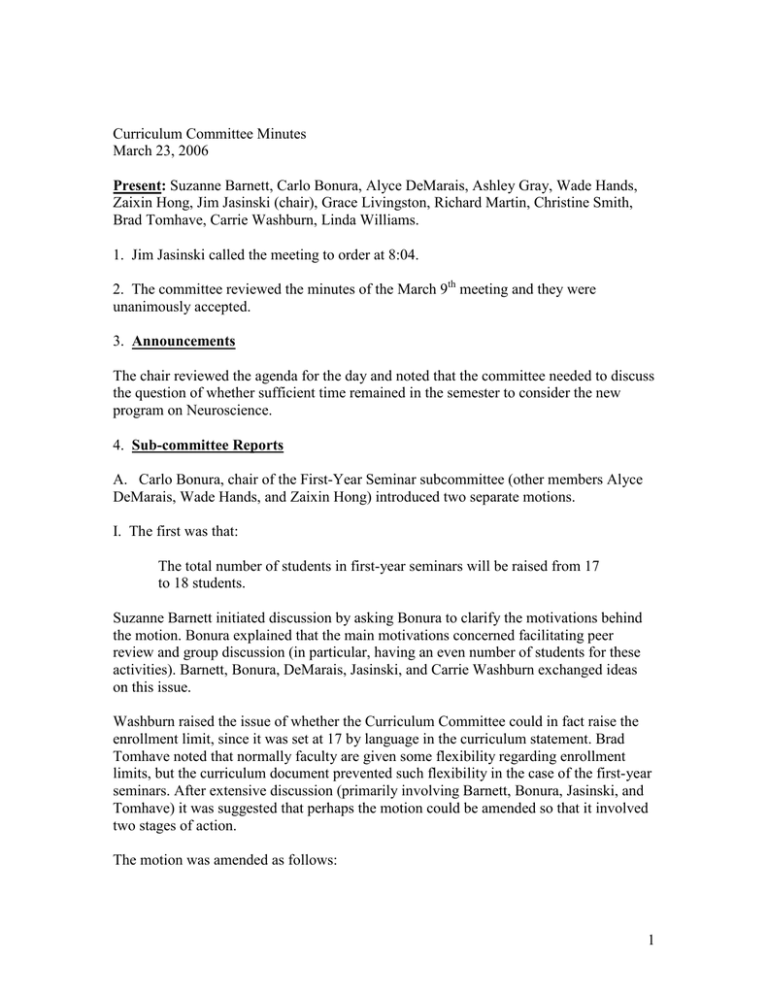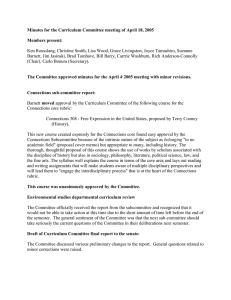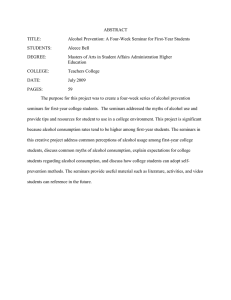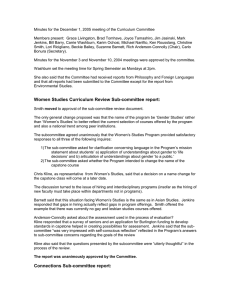Curriculum Committee Minutes March 23, 2006
advertisement

Curriculum Committee Minutes March 23, 2006 Present: Suzanne Barnett, Carlo Bonura, Alyce DeMarais, Ashley Gray, Wade Hands, Zaixin Hong, Jim Jasinski (chair), Grace Livingston, Richard Martin, Christine Smith, Brad Tomhave, Carrie Washburn, Linda Williams. 1. Jim Jasinski called the meeting to order at 8:04. 2. The committee reviewed the minutes of the March 9th meeting and they were unanimously accepted. 3. Announcements The chair reviewed the agenda for the day and noted that the committee needed to discuss the question of whether sufficient time remained in the semester to consider the new program on Neuroscience. 4. Sub-committee Reports A. Carlo Bonura, chair of the First-Year Seminar subcommittee (other members Alyce DeMarais, Wade Hands, and Zaixin Hong) introduced two separate motions. I. The first was that: The total number of students in first-year seminars will be raised from 17 to 18 students. Suzanne Barnett initiated discussion by asking Bonura to clarify the motivations behind the motion. Bonura explained that the main motivations concerned facilitating peer review and group discussion (in particular, having an even number of students for these activities). Barnett, Bonura, DeMarais, Jasinski, and Carrie Washburn exchanged ideas on this issue. Washburn raised the issue of whether the Curriculum Committee could in fact raise the enrollment limit, since it was set at 17 by language in the curriculum statement. Brad Tomhave noted that normally faculty are given some flexibility regarding enrollment limits, but the curriculum document prevented such flexibility in the case of the first-year seminars. After extensive discussion (primarily involving Barnett, Bonura, Jasinski, and Tomhave) it was suggested that perhaps the motion could be amended so that it involved two stages of action. The motion was amended as follows: 1 i) Faculty will be allowed to add an 18th seat in first-year seminars. ii) The Curriculum Committee will recommend to the Faculty Senate to increase enrollment in the first-year seminars from 17 to 18, The amended motion was passed (with one “no” vote and one abstention) II. Bonura introduced the second motion: The subcommittee moves to revise the current policy regarding first-year seminars that maintains separate first-year and transfer (and continuing) student seminars. Under the new policy, these two groups of students will remain separate during the fall semester of each year. During the spring semester of each year, all first-year seminars will be combined seminars. The enrollment of transfer or (non-first-year) continuing students in a combined spring semester seminar will be limited to four students. Bonura noted various arguments that had been offered in favor of the change (within the subcommittee and also in discussions with Jack Roundy). These included: a. The realization that the motion involved a compromise. On one hand there was a desire to keep the true first-time-in-college student separate from the more seasoned transfer and continuing students, but on the other hand there were certain enrollment realities that had to be accommodated. b. Transfer students often express that under the current system they do not feel like they have as much choice as the first-time-in-college students. c. The change would improve the integration of transfer students into campus life. d. The first-year seminars serve two very different functions: they provide a unique, and somewhat protected, learning environment for first-year students, and they also provide (two) important academic experiences. Under the proposed change, the fall seminars would still fulfill both functions, while the spring semester would emphasize only the latter. e. The fact that neither of the two groups – first-year-in-college and transfer/continuing – are homogeneous. Evidence suggests that intra-group intellectual variation seems to be as great as inter-group variation. Discussion ensued (involving Barnett, Bonura, Jasinski, Tomhave and Washburn) about how the “four” in the last sentence of the motion could/should be enforced. Washburn noted that it was desirable because it would prevent transfer/continuing students from dominating any particular spring seminar. Others responded that such domination was 2 very unlikely given the numbers of students involved. Jasinski noted that the potential lack of enforceability of the four student limit would make the entire motion problematic regardless of how one felt about the general idea. Several people suggested that perhaps the last sentence in the motion could be struck. Tomhave moved that the last sentence be removed from the motion. The motion passes (with one “no” and four abstentions). The amended motion was then voted on and passed unanimously. 5. Other Business Jasinski reviewed the tasks ahead for the next meeting scheduled for March 30 at 8:00 AM. These include reports from the first-year seminars subcommittee and the connections subcommittee. In addition there will be discussion of the Occupational Therapy and Dual Degree Engineering program. Jasinski noted that the a decision needed to be made about whether the committee would consider approval of the new program (Interdisciplinary Transcript Designation Emphasis) in neuroscience this semester or wait until next fall. He noted that John Finney had suggested that it would be very useful for the Curriculum Committee to review the neuroscience proposal this spring since it would facilitate planning for the health sciences center. There was a brief discussion about the formation of a neuroscience subcommittee. Given that there was no strenuous objection, Jasinski concluded that the committee was willing to initiate its review of the neuroscience program and attempt to reach a conclusion before the end of the semester. He and DeMarais will meet to appoint a neuroscience subcommittee. The meeting adjourned at 8:56. 3


